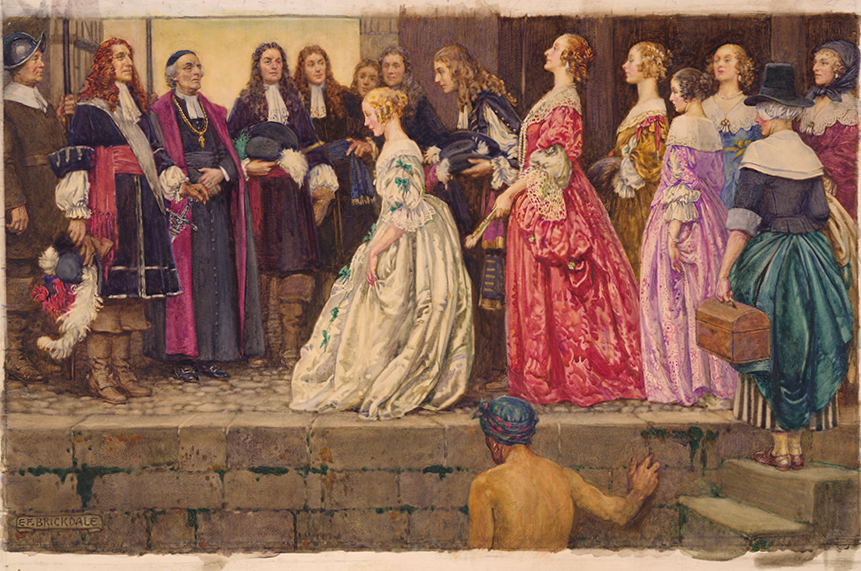Home / Early Encounters, 1492-1734 / French Colonies / Marrying into the New World
Resource
Marrying into the New World
This painting depicts the women who moved to New France to marry eligible colonists in exchange for free passage and a small dowry.
- About
-
Curriculum
- Introduction
-
Units
- 1492–1734Early Encounters
- 1692-1783Settler Colonialism and the Revolution
- 1783-1828Building a New Nation
- 1828-1869Expansions and Inequalities
- 1832-1877A Nation Divided
- 1866-1898Industry and Empire
- 1889-1920Modernizing America
- 1920–1948Confidence and Crises
- 1948-1977Growth and Turmoil
- 1977-2001End of the Twentieth Century
- Discover
-
Search
Background
New France was built on the fur trade and political alliances, so its population consisted primarily of soldiers, fur trappers, and missionaries. By the 1660s unmarried French men outnumbered unmarried French women in the colony twelve to one. This was a major problem for the colonial government. They were trying to build a permanent colony, but without women, the colony’s population could not grow. This made the territory vulnerable to invasion by the English and Spanish.
To address this problem, King Louis XIV proclaimed that any woman who agreed to move to New France and marry a colonist would receive free passage across the Atlantic and a small dowry. Between 1662 and 1673, about 800 women took his offer. They were nicknamed the Filles du Roi (“Daughters of the King”).
Most of the Filles du Roi were poor, but some women were born to honorable families that had fallen on hard times. Without a substantial dowry, they could not hope to make a good marriage in France, and without a good marriage, their future was uncertain. The opportunity to start over with a small dowry and guaranteed husband was appealing. If their new husbands were successful, they might attain a comfortable life and respectable position in society. The women from noble families would marry the higher-ranking men in the colony.
When the Filles du Roi arrived in New France, they were immediately introduced to the eligible bachelors of the colony. The bachelors could then propose to any woman they wanted. A royal order required the men to propose within two weeks or be deprived of their right to fish and trade. The women had the right to refuse proposals from men they did not like. Within six months of their arrival, eighty percent of the women were married.
About the Image
In this painting, the newly arrived Filles du Roi are presented to the two most powerful men in New France: the intendant and bishop of Quebec. The women’s clothing indicates their high status in French society, and the ceremonial welcome speaks to their importance to the colony. This painting was made in the 1800s to celebrate the Filles du Roi as founding mothers of the French-Canada. But this depiction is not historically accurate. When the Filles du Roi first arrived in the 1600s they were not treated this honorably. Some men even referred to them as cattle.
Vocabulary
- bishop: High-ranking member of the Catholic Church.
- dowry: Property a woman brought with her to a marriage.
- Filles du Roi (“Daughters of the King”): Women who agreed to move to New France and marry colonists in exchange for passage across the Atlantic and a dowry.
- intendent: Highest-ranking government official in New France.
Discussion Questions
- What ceremony is being shown in this image? What does this ceremony reveal about the attitude toward the Filles du Roi in the 1800s?
- What does the clothing of the Filles du Roi reveal about their status and their role in the colony?
- What does the decision of the Filles du Roi to travel across the world reveal about the opportunities for women in Europe and the Americas?
- How does this story complicate our understanding of the reasons for immigrating to the New World?
- Why do you think the artist made this painting? Why is it important to consider the context in which a painting is made?
Suggested Activities
- APUSH Connection: 2.7 Colonial Society and Culture
- Conduct a close reading of this painting for clues about life in New France. Particular attention should be paid to the power dynamics and class signifiers the artist has chosen to include. Who is in power in this image? Who does not have power? How did the artist depict these dynamics? Are there any further clues about life in New France in this painting?
- Pair this resource with Populating the Colonies and consider what life was like for the Filles du Roi after marriage.
- New France was not the only colony where men significantly outnumbered women. Combine this resource with Tobacco Brides in Virginia. What were the differences and similarities between the Filles du Roi and the Tobacco Brides?
- Combine this image with Life Story: Charlotte-Françoise Juchereau de Saint-Denis for a larger lesson about the status and experiences of women of French descent in New France.
- The Filles du Roi used marriage to improve their social standing. For other examples of women who used marriage as a way to improve their life circumstances, use any of the following resources:
Themes
IMMIGRATION, MIGRATION, AND SETTLEMENT







